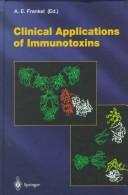| Listing 1 - 5 of 5 |
Sort by
|
Article
Year: 1904 Publisher: Leipzig : Georg Thieme,
Abstract | Keywords | Export | Availability | Bookmark
 Loading...
Loading...Choose an application
- Reference Manager
- EndNote
- RefWorks (Direct export to RefWorks)
Dissertation
Year: 1897 Publisher: Berlin : L. Schumacher,
Abstract | Keywords | Export | Availability | Bookmark
 Loading...
Loading...Choose an application
- Reference Manager
- EndNote
- RefWorks (Direct export to RefWorks)
Milk --- Diphtheria toxin. --- Diphtheria. --- Sterilization. --- Sterilization.
Dissertation
Abstract | Keywords | Export | Availability | Bookmark
 Loading...
Loading...Choose an application
- Reference Manager
- EndNote
- RefWorks (Direct export to RefWorks)
Diphtheria Toxin --- Resting Phase, Cell Cycle --- Granulocyte-Macrophage Colony-Stimulating Factor --- Leukemia, Myeloid, Acute --- Recombinant Fusion Proteins --- Interferons --- Cell Cycle --- therapeutic use --- drug effects --- therapeutic use --- drug therapy --- therapeutic use --- pharmacology --- drug effects
Book
ISBN: 9400776233 9400776241 Year: 2014 Publisher: Dordrecht : Springer Netherlands : Imprint: Springer,
Abstract | Keywords | Export | Availability | Bookmark
 Loading...
Loading...Choose an application
- Reference Manager
- EndNote
- RefWorks (Direct export to RefWorks)
Corynebacterium diphtheriae is the classical etiological agent of diphtheria and the type strain of the genus Corynebacterium. While diphtheria of the respiratory tract became rare with the introduction of vaccination programs in industrialized countries, even today several thousand cases per year are reported to the World Health Organization. This shows that diphtheria is not completely eradicated and that reservoirs exist. The book summarizes the latest advances made in understanding C. diphtheriae and the closely related species Corynebacterium ulcerans and Corynebacterium pseudotuberculosis. Topics addressed are genomics of toxigenic corynebacteria, host-pathogen-interaction, detection, surveillance and treatment as well as application aspects.
Corynebacterium diphtheriae. --- Diphtheria toxin. --- Bacillus diphtheriae --- Klebs-Loeffler bacillus --- Medicine. --- Medical microbiology. --- Parasitology. --- Epidemiology. --- Bacteriology. --- Microbial genetics. --- Microbial genomics. --- Biomedicine. --- Medical Microbiology. --- Microbial Genetics and Genomics. --- Bacterial toxins --- Corynebacterium --- Microbiology. --- Medical parasitology. --- Genomics --- Microbial genetics --- Microorganisms --- Genetics --- Microbiology --- Human beings --- Human parasitology --- Medical sciences --- Parasitology --- Parasitic diseases --- Diseases --- Public health --- Microbial biology --- Biology --- Parasites

ISBN: 3540640975 3642721559 3642721532 Year: 1998 Volume: 234 Publisher: Berlin : Springer,
Abstract | Keywords | Export | Availability | Bookmark
 Loading...
Loading...Choose an application
- Reference Manager
- EndNote
- RefWorks (Direct export to RefWorks)
1 2 D. FITZGERALDI, I. PASTAN , and J. ROBERTUS Introduction . . . . . . . . . . . . . I 2 Toxin Structure-Function Properties 2 2. 1 Functions. . . . . . . . . . . . . . . . . . . . . . . . 2 2. 2 Binding. . . . . . . . . . . . . . . . . . . . . . . . . 3 3 Intracellular Processing - Cleavage and Reduction . . . . . . 4 3. 1 Cytosolic Activity . . . . . . . . . . . . . . . . 5 4 Immunotoxin Design and Testing. 6 5 Conclusion. . 8 References. . . . . 8 1 Introduction While various treatment approaches for cancer include reversal of the transformed phenotype, stimulation of immune responses, inhibition of metastatic spread and deprivation of key nutrients, the goal of immunotoxin treatment is the direct killing of malignant cells. Because they are enzymatic proteins that act catalytically to kill cells, bacterial and plant toxins are often employed as the cell-killing component of immunotoxins. Here we provide background information into the structure-func tion relationships of toxins and discuss how they can be combined with cell-binding antibodies or other ligands to generate immunotoxins. Bacterial and plant toxins (e. g. , diphtheria toxin, Pseudomonas exotoxin and ricin) are among the most toxic substances known. However, because they bind to cell surface receptors that are present on most normal cells, unmodified toxins are generally useless as anti-cancer agents. To convert toxins into more selective agents, their binding domains are either eliminated or disabled and replaceq with cell binding antibodies that are tumor-selective.
Farmacologie [Immuno] --- Immunofarmacologie --- Immunopharmacologie --- Immunopharmacology --- Pharmacoimmunology --- Pharmacologie [Immuno] --- Immunotoxins --- Diphtheria toxin --- Ricin --- therapeutic use --- pharmacology --- therapeutic use. --- pharmacology. --- Therapeutic use. --- Pharmacology. --- Antibody-toxin conjugates --- Therapeutic use --- Immunology. --- Cancer research. --- Hematology. --- Cancer Research. --- Pharmacology/Toxicology. --- Drug effects --- Medical pharmacology --- Medical sciences --- Chemicals --- Chemotherapy --- Drugs --- Pharmacy --- Haematology --- Internal medicine --- Blood --- Cancer research --- Immunobiology --- Life sciences --- Serology --- Physiological effect --- Diseases --- Antibody-toxin conjugates. --- Conjugates, Antibody-toxin --- Immunoconjugates --- Immunoglobulin-toxin conjugates --- Toxin-antibody conjugates --- Toxin-immunoglobulin conjugates --- Bioconjugates --- Immunotoxicology --- Toxins
| Listing 1 - 5 of 5 |
Sort by
|

 Search
Search Feedback
Feedback About UniCat
About UniCat  Help
Help News
News